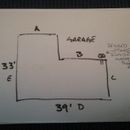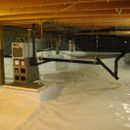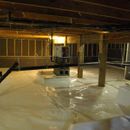Sub-membrane radon mitigation system
Hey Folks – hope you get this question of mine regarding my encapsulated crawlspace. Some years ago you gave me guidance before the undertaking.
To Re-Cap –
Crawl cleaned and graded (no bulk water issues)
Two Thirds of the crawl was then lined with 550 felt underlay. My dirt was clean – few river style rocks, but my friend gave me the felt roll because his crawl was sand and he didn’t use it when he did his crawlspace.
Foundation and dirt floor lined with 20 mil. vapor barrier. Seams overlapped and taped, sealed and mechanically fastened to upper ends of the foundation shelf with fir strips.
All knee walls – rim joist bays – and foundation are insulated to 4″ of Polyiso and foam sealed.
All wire -plumbing holes foam sealed in the crawl. (As was my attic)(stack effect)(attic done later).
The de-humidification in the crawl has been great. It’s managed and maintained to 50% RH.
The dehum does a test cycle each hour, and typically shuts down. No service required. If it does run – it is brief. Temps stays around 63*.
I was encouraged at the time to insulate on top of the liner (or even under). It would help the labor of the dehum. I couldn’t afford any additional insulation at the time.
The efforts in the crawlspace at the time were to understand where all my indoor humidity was coming from. Not Radon.
The R/H in the conditioned area of the home improved after crawl encapsulation, yet in turn, I incorporated a separate whole house dehum to satisfy the conditioned area. The conditioned area of the home is now managed at 50% RH.
Radon –
A few weeks ago, cleaning out my work area in the garage – I came across a sealed Radon Test Kit. It came with all the crawlspace encapsulation materials when I did the crawlspace. I elected to do the short term test for Radon.
The test results after 48 hours was 4.2 picocuries. It was recommended that I seek help for Radon Mitigation.
I would like to express that I am comfortable with incorporating a Radon fan
to mitigate my Radon issue -( SMD – Sub Membrane Depressurization).
But I have a few questions.
1) How much corrugated pipe do in run? Run the perimeter just off the foundation walls?
2) 3″ or 4″ corrugated pipe?
3) Number of suction points
4) Can you recommend a quiet fan?
Attached are a few pics – in the penciled diagram it references the foot print of the crawlspace. I would like to go through the rim joist into the garage (using a fire ring) then into the attic above my garage and through the roof.
Thanks for your time and considerations.
William –
Bellingham, Washington.
GBA Detail Library
A collection of one thousand construction details organized by climate and house part












Replies
Putting it into perspective, 4.2 picocuries/liter or 155Bq/m3 (in the crawlspace, no less) would not require mitigation anywhere in Europe, even for new construction. Action levels there start at 200 Bq/m3 (5.4 pCi/l ) for new construction, 400 Bq/m3 (10.8 pCi/l) for retrofits, and those are ANNUAL AVERAGES, not short term test numbers.
Everything from seaonal changes in stack effect drives to seasonal changes in subsoil moisture level affect how much radon will show up in your house. A short term test does not tell you anything about the annual exposure, and unless you're sleeping in the crawlspace the levels there are pretty much irrelevant. There are far more important things to be worring about and spending money on than remediating a 4.2 PCi/l level in the crawlspace.
At the VERY least run a long term test before doing anything.
And if you insist on forging forward, before diving in to a full-on depressurization approach mere 10 cfm exhaust-only ventilation for a crawlspace that size would likely cut the 4.2 PCi/l in half, or somewhere close to the outdoor background levels without creating an elaborate sub-membrane depressurization system.
Thank you for the reply.
The 4.2 readings were taken inside the conditioned area of the home.
I understand your advice on a longer term test. My lab informed me of the same.
It's that I feel I read everywhere online, as well as the recommendations of the Lab that tested my sample - that anything over 4.0 picocuries should require mitigation.
I too have read that seasonal conditions can vary the readings.
I have already ordered a bit more membrane material(s) anticipating cutting into the current membrane to install corrugated pipe. Have yet to order a fan. The added expense at this point in not bad... I just see vague examples of a PVC fitting under the membrane, a few pics of longer lengths, even a few that encompass the perimeter.
A 10 cfm exhaust only fan... Would it not be best to get the gas before it enters the crawl?
We do frequent the space during the seasons, holiday ornaments are kept there, even emergency supplies.
Thanks for you time and considerations.
>"The 4.2 readings were taken inside the conditioned area of the home.
------
>"A 10 cfm exhaust only fan... Would it not be best to get the gas before it enters the crawl? We do frequent the space during the seasons, holiday ornaments are kept there, even emergency supplies."
You don't live in the crawlspace. It's best to get the gas before it enters the CONDITIONED LIVING SPACE. Depressurizing the crawlspace relative to the conditioned space is the moral equivalent of depressurizing under the membrane, but a lot easier to implement. Take the time to air seal the plumbing/electrical/other penetrations of the subfloor to make it more effective. If the 4.2 PCi/l is the annual average upstairs, air sealing the subfloor alone would probably be sufficient to get it under the 4.20 PCi/l EPA advisory level (even without the fan.)
Do you spend several HOURS EVERY DAY sorting ornaments and stacking emergency supplies in the crawlspace? Add it all up and it's unlikely you're spending more than 20 hours (out of the 8760 hours in) a year in the crawlspace, which isn't a significant duty cycle or accumulated dose. You get similar magnitude gulps of "extra" radiation every time you spend a day skiing.
Mr. Dorsett - the 10 cfm fan you make mention of.
Not sure if I could mention a brand name here. But - the Panasonic FV-10NLF1E Whisper Line. Would that work. Can that type fan run continuously? I just want a QUIET fan. I am in the woods here and and the house is very peaceful
If you could share perhaps a name/style type you are referring to it would perhaps put this to rest.
Thanks - William
Copy that message received.
Thank you for your input.
You did what appears to be a very nice job with your encapsulation. If you cut a slit in your poly you can slide six or eight ft of rigid or flexible drain tile pipe under the poly. Slip your suction into the drain pipe and that will be all you need to do under the floor. The installation you describe is our preferred method. Use a small radon fan. You might need to try a couple. If you achieve a minimum of about 20 CF per Minute, up to about 60, you are likely good and in addition to cutting you radon levels likely to around 1. p you will likely cut your humidity a good bit. Radon systems are generally very quiet. Yours not so much as the poly passes the noise like its not even there. If the noise is a problem you can bury your drain pipe a foot or so. It will work great either way.
Hey Mike - if your out there - a bit of a clarification.
You wrote - If the noise is a problem you can bury your drain pipe a foot or so. It will work great either way.
Would I bury it in gravel?
Thanks - Wiliam
Thank you very much for the reply. As well as the compliment towards my energies encapsulating the crawlspace. I actually love it. I searched the web years ago and kind of got the gist. This site alone gave me good guidance. However; I say with a smile, I wish I was just guided to consider the Radon issue. Hence; my concerns to do it now.
As a retired spray painter of 30 years, where breathing air was my lively hood, I try to grasp the idea of a Radon fan pulling any gas out from under the VB - other than beyond a few inches past the corrugated pipe. Now your saying I can dig deeper? And it will still vacate Radon?
Great information on the noise. Our home is in a very peaceful place. One could nearly hear a penny drop at night. We certainly don't want to lay - trying to sleep with our master bedroom just above the crawl...
Again; I have already ordered some liner anticipating cutting into the VB. You say 6-8 feet will suffice. But trust me - I am willing to go around the perimeter if it would be best?
I have installed a few underground sprinkler systems in my days. I liken in my mind a need to
centralize the water supply to reach all locations respectably at the same time. I have no problems going around the perimeter - even the infield area with corrugated it it will achieve positive results.
Radon today is my concern.
Noise from the mitigation system a concern.
Thanks again for anything you are willing to share and have shared.
William
All reasonable thoughts. An easier method would be to suck in two or three spots but hang the pipe from your floor joist with three drops under the poly. We like to use 3 or 4 inch schedule 40 cellular pvc. It is quieter, stronger and insulates a bit so less condensation in the pipe. It is worth trying it without burying it. You may not notice the noise. You won't hear it in the garage. Often the manometer is the only way to tell it is running.
Mike - more clarification -
You wrote - We like to use 3 or 4 inch schedule 40 cellular pvc. It is quieter, stronger and insulates a bit so less condensation in the pipe.
The cellular PVC - above the grade/liner? Noise is my concern.
Thanks William
Yes, above the liner. The pipe will not be a meaningful source of noise. The suction point and fan and exhaust generate the most noise. The poly will do little to quiet the suction.
Put a speaker in a plastic bag as a test.
Why bother with a fan at all, just run the pipe up and let the stack effect depressurize it for free
Because it rarely works unless you really don't need it.
Normally a stack effect is assisted by temperature differential I believe.
You are trying to suck air out from under the poly before it gets in the house and the house is trying to suck air from under the poly into the house. The stack effect of the house is too strong for a pipe with no fan to overcome, usually.
Thanks again for your time and input.
Although said earlier in the thread - a 10 cfm fan through an exterior opening may suffice in bringing down the levels in the living space. As easier, cheaper, in all aspects, I am going to approach this in an SMD manner.
The crawlspace as depicted above is an "L" shape. My plan is the run 2 - 4" perforated schedule 40 pvc pipes 20' long down the center of each leg and have 2 suction points about center of each leg. 2/3 rds of the crawlspace is lined over the soil with 550 Felt. I hope this will aide in the communication of airflow.
The floor joist cavities are un-insulated. I have a concern with the noise the system may create. So my intentions are to trench down a foot or so and install the PVC and clean gravel. I will use a bit of ingenuity around the suction points to mitigate as much sound as I need to. I just have no idea as to the noise these systems create.
I presently have 2 Dehums installed there. One services the crawl, the other the conditioned area of the home. I can faintly hear a Dehum kick on every now and again at bed time. I hate to cut into the liner after all that work has already been done, but I have a roll of 42" wide material to seal it back up. I don't want to try it, and have to do it a 3rd time.
Upwards - I will use the foam core PVC to help mitigate noise and provide some insulation to help with condensation issues. All is planned to be routed through the rim joist in the garage with fire rings where the fan is to be installed in the attic.
It will have it's own circuit - switch and light at the fan's location.
If any of the above is missing anything - let me know.
Mike it leaves me in the dark as far as the fan size... I kind of bite my nails trying to understand what should be needed. If you could spell out a good brand name (if that's allowed here) and model that would be appreciated.
I have read a bit on the new "low voltage" 24 volt fans? I am all ears.
Remember to pitch the pipe about 3/8 in per foot back towards your suction points. You can't be sure of the fan size until you install it and a manometer installed. Get the smallest or only one they have at your local big box store. Use the chart included to calculate your cfm. 20 to 60 maybe 80 cfm.
It will be way quieter than your dehumidifier. I think you will be pleased. You always want to use the smallest fan you can, that is why I say 20 cfm will do.
After a bit you should see the poly tighten up a bit. The low voltage fans we have bought are collecting dust as they are louder. Quite a bit louder. You might just get power from the garage door opener receptacle.
Copy that - pitch to the pipe towards suction points.
Thanks Mike - I just want to do it well, and do it right.
Have a good weekend.